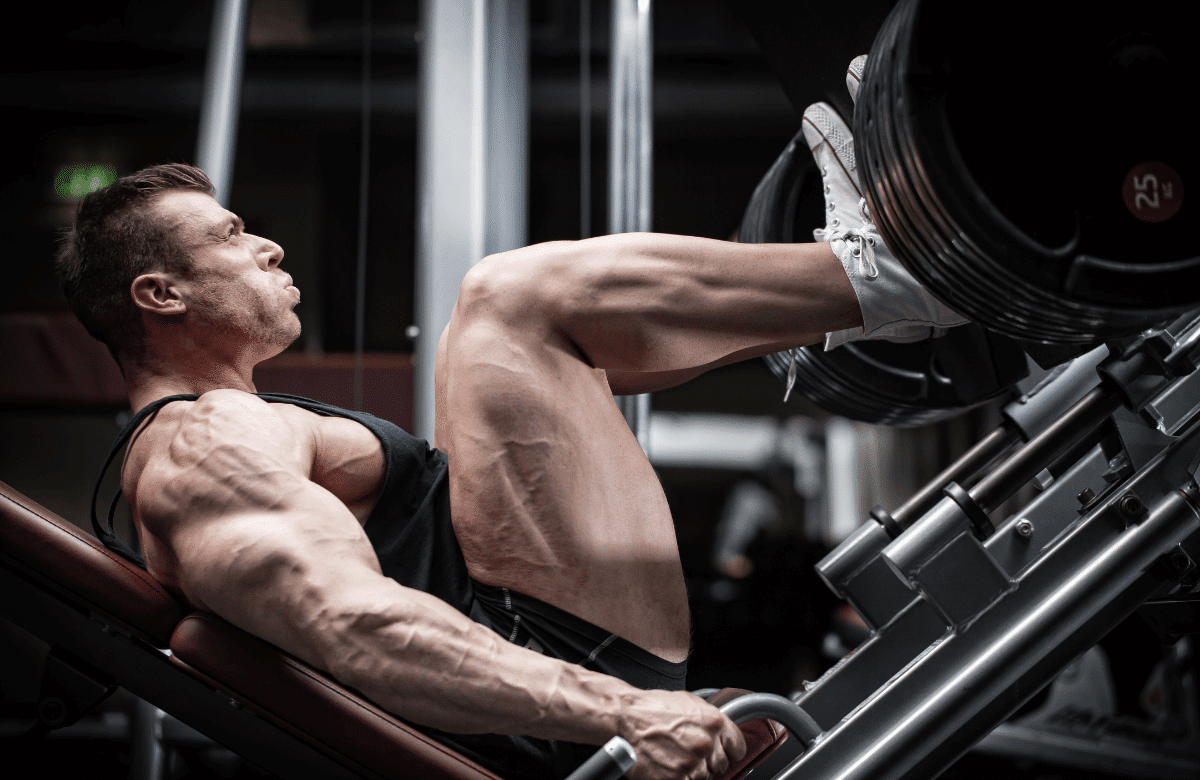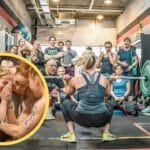The glutes are the largest muscle in the body, helping you stand, walk, climb stairs, and more. It’s an important muscle, so wanting maximum glute gains is entirely understandable.
You’ve seen exercises like the hip thrust and split squat, but what about the leg press for the glutes?
The leg press machine can be an excellent tool for targeting the lower body, including the glutes. We cover everything you need to know on how to engage the glutes, the benefits, mistakes to avoid, and more in the article below. Read on for more information.
Jump to:
What Is the Leg Press Machine?
Before you can build stronger glutes, you’ll need to understand the leg press machine. The leg press is a powerful compound movement that can target the glutes, hamstrings, calves, and quad muscles.
The machine is easy to use and beginner friendly. There are two primary kinds of leg press machines, including the following:
- 45-Degree Leg Press Machine
- Horizontal Leg Press Machine
You may also see a vertical leg press machine, but this piece of equipment is much more rare. The different types of leg press machines you select will change the load capacity, technique, and muscles activated.
Seated Leg Press Machine
The Horizontal or Seated Leg Press Machine uses a pin-load system that’s suitable for beginners. This piece of gym equipment is easier on the joints compared to the 45-degree option.
The seated leg press has an upright seat with a foot platform directly in front of it. The load is applied in a horizontal plane, hence the name, horizontal leg press machine.
This type of leg press machine can be used for glute workouts alongside other muscles in the lower body, like the hamstrings, quads, and calves.

45-Degree Leg Press Machine
The 45-Degree or Lying Leg Press Machine is the most common type of option you’ll see in commercial gyms. It’s more advanced, as it’s plate-loaded. You can adjust the load by adding or removing weight plates.
This option has a solid foot pad that moves through a 45-degree motion with a set of metal tracks. You typically load the weights on the peg sleeves on either side of the unit.
If you position your legs higher up on the foot platform, you can get more glute activation rather than the quads.
Muscles Worked on the Leg Press
As the name suggests, the leg press exercise engages the leg muscles. It’s an excellent exercise for building body mass in muscles like the following:
The activity of muscles involved will change depending on your foot placement, allowing you to adjust the type of training to suit your fitness goals.
Quadriceps
The quadriceps femoris is one of the largest and strongest muscles in the human body. It’s composed of four individual muscles and works as a hip flexor and knee extensor. The muscle is used in kicking, jumping, walking, climbing stairs, squatting, and more.
When you push the foot pad back to the top of the machine, your quads work to straighten your knees.
Glute Muscles
The gluteus maximus, or glute muscles, is the largest and strongest muscle in the body. The gluteal muscle’s size allows you to generate significant amounts of force. Strong glutes help you in activities like climbing stairs, stepping up, and running.
The glutes and hamstrings work to straighten the hips when you press the platform up on the leg press machines. The outer glutes also work to keep the knees in line with the feet.
Glute-focused leg press workouts can improve functional strength, reduce the risk of injury, enhance posture, and more.
Hamstrings
The hamstrings consist of three muscles located on the back of the thigh between the hip and knees. The muscles work to extend the hip and flex the knee. You use the hamstrings for daily activities like walking, running, and bending.
Calves
The calf is composed of two muscles known as the gastrocnemius and the soleus. These muscles come together at the Achilles tendon, which connects to the heel bone. It’s a complex muscle that’s fundamental for walking, posture, jumping, and other activities.
The calves help to support the quads during the leg press, keeping the knees straight in the process.
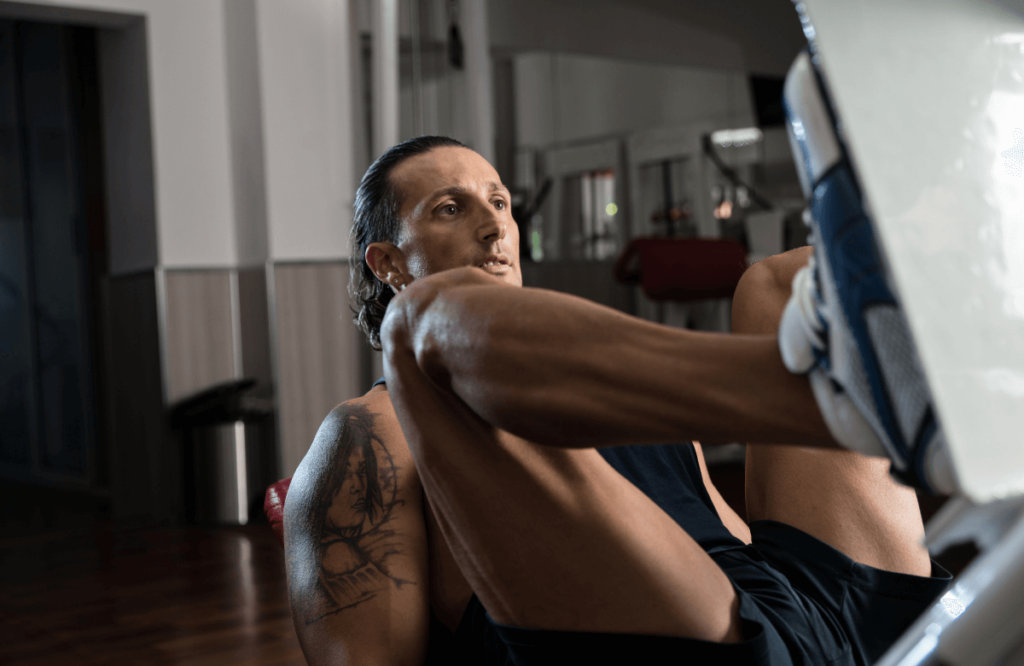
The Benefits of the Leg Press Machine
There are loads of potential benefits to using the leg press machine besides just glute development. It’s a powerful piece of equipment that’s safe, effective, and suited for any strength level. It can be used to build glute strength, target the lower body, and works well in most workout routines.
Beginner Friendly
Although you might see gym-goers loading heavy weights onto the leg press machine, it’s suited for all experience and activity levels. The lying leg press is more complex than the seated variant, but new or average lifters can quickly learn the proper form.
Seated machines with pin-loaded mechanisms are even easier to use and have little risk of injury.
Leg workouts on the press machine may not be as intimidating as barbell squats or deadlifts. This can help new lifters stay motivated and get in a good leg workout. Overall, it offers practical exercises that suit any workout program or experience level.
Great for Lower Body Workouts
The leg press machine can be effective for all muscles in the lower body, not just for glute training. You can target major muscle groups, like the quads and hamstrings, leading to more muscle growth.
When you combine leg press glute workouts with other compound lifts—like squats and deadlifts—you will see even more improvements in your body composition and strength.
Good for Recovery
Unlike standard squats or deadlifts, the press machine places less pressure on the spine and lower back. This makes it a fantastic alternative to squats for individuals with back pain or prior back injuries.
Squat exercises can have a higher chance of injury, like falling over or using improper technique. That being said, it’s best to consult with your physician or physical therapist if you’re recovering from an injury.
Easy Progression
Both types of leg press machines allow you to progressively overload your lower body muscles. You can start with lighter weights and slowly work your way up toward heavier weights for maximum glute growth. This makes the machine suited for advanced lifters or newcomers alike.

Does My Foot Position Change Muscle Activation?
It’s easy to sit on the leg press machine and not give much thought to your foot placement. But different foot positions can change the muscles recruited and the effectiveness of your glutes workout.
High Position
Raising your feet higher up on the pad shifts the muscle recruitment to the posterior chain. This position engages the glutes and hamstrings more than the quadriceps. It’s a better option if you’re looking for maximum glute gains.
Middle Position
A normal foot position is typically in the middle of the foot platform around shoulder-width apart. This is the standard position and activates the quadriceps, hamstrings, and glutes equally. You should assume this stance if your goal is balanced lower body development.
Low Position
A lower position toward the bottom of the foot platform allows you to engage the quadriceps and calves. This position doesn’t target the glutes or hamstrings as much, so it may be wise to leave it out of your glute-focused regimen.
Narrow Feet
A narrow foot stance, with the feet around hip distance apart, targets the quadriceps. This position doesn’t engage the glutes and hamstrings as much. Narrow feet positions can also limit the range of motion, which may be beneficial for some training goals.
Wide Feet
With a wide foot stance, you have your feet wider than shoulder distance apart. This variation engages the glutes and hamstrings, as you have to recruit the muscles on the outside of the hips. This stance requires a good bit of hip flexibility, strength, and stability.
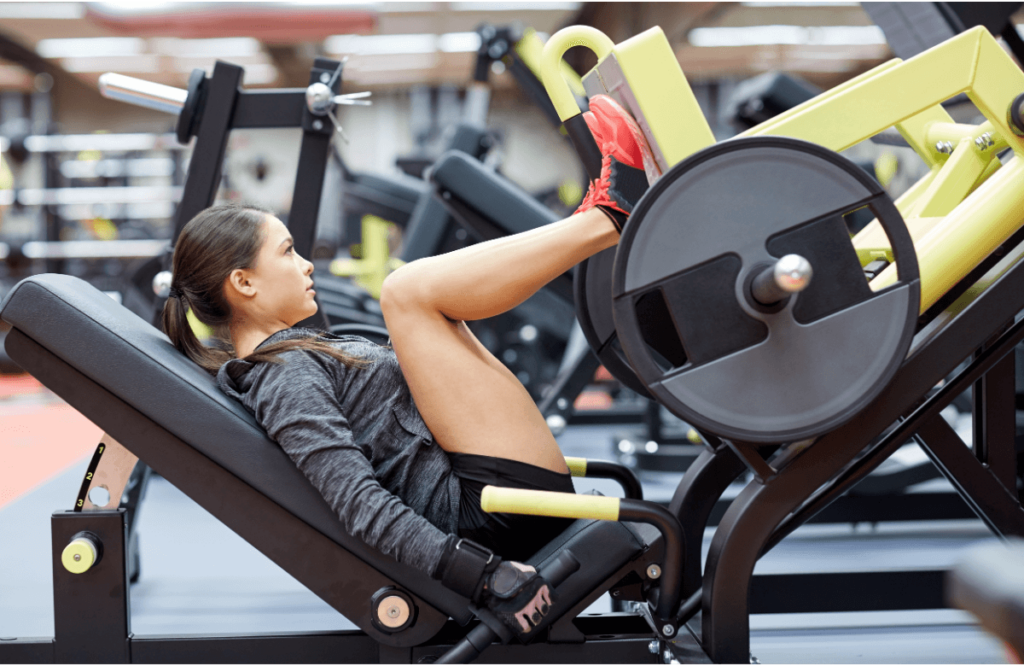
How to Target the Glutes Muscles
So, how can you get the most glute activation on the leg press? Here are a few leg press variations you can incorporate to engage the gluteal muscles.
Go Deeper
Deeper repetitions will engage the glutes more on the leg press. A deeper range of motion provides more hip extension, which is one of the primary ways to engage the gluteal muscles. Using heavier weights can also strengthen the muscle, so consider loads in the 5-10 rep range.
Here’s how to get deeper reps on the leg press machine:
- Get on the machine and lie down on the seat or backrest.
- Place your feet in the middle of the platform.
- Make sure your feet are about as wide apart as your shoulders.
- Turn your toes slightly outward at an angle of around 15 to 30 degrees.
- Lower yourself as much as you can while keeping your feet flat on the platform.
Point Your Toes Outward
Glute activation happens with hip abduction or lifting the leg to the sides. The glutes are used in the external rotation of the hip joint, so pointing your toes outward can help engage the muscle.
You may notice more engagement at the top of your glutes than at the bottom.
Here’s the proper form for pointing the toes outward:
- Step into the leg press machine and lie down on the seat or backrest.
- Place your feet in the middle of the platform.
- Make sure your feet are approximately shoulder-width apart.
- Turn your toes out at a wider angle, around 45 to 60 degrees.
- Remember to push your knees outward during your entire set to maintain proper form and alignment.
Use a Wide Stance
Another way to engage the glute fibers is to use a wider stance than usual. A wide stance requires additional hip abduction, which employs more glute fibers. Here’s how to widen your stance on the leg press machine:
- Step into the leg press machine and sit on the seat or backrest.
- Place your feet in the middle of the platform.
- Make sure your feet are positioned about as wide apart as your shoulders.
- Slightly angle your toes outward, around 15 to 30 degrees.
- Push your knees out forcefully to maintain alignment with your feet throughout your exercise.
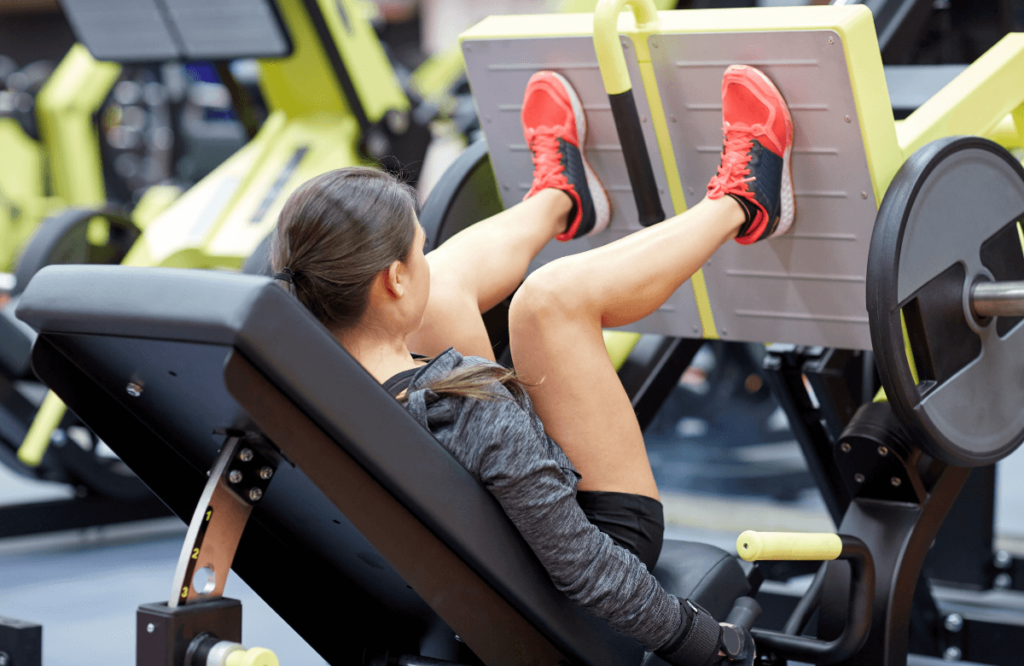
Place Your Feet Higher
One of the easiest ways to target the glutes is to place your feet higher on the foot pads. Instead of positioning your feet in the center of the platform, place them higher up with your toes nearing the edge. This stance requires more hip flexion and less knee travel.
Here’s how:
- Step into the leg press machine and lie down on the seat or backrest.
- Place your feet near the top of the platform, with your toes almost at the edge.
- Make sure your feet are positioned about as wide apart as your shoulders.
- Slightly angle your toes outward, around 15 to 30 degrees.
- Throughout your set, focus on keeping your shins as straight as possible while pressing the platform.
Perform Variations
The Side-Lying Leg Press is one leg press alternative that can target the glutes. With this exercise, you lay on your side and press the platforming using one leg. It’s a unilateral exercise that provides more hip flexion and challenges the glutes.
Because you train each side independently, you’ll also recruit more stabilizing muscles. It’s recommended to use the seated leg press machine, as it will be more comfortable than its 45-degree counterpart.
Here’s how to perform the side-lying leg press:
- Step inside the leg press machine and lie on your side on the seat or backrest.
- Position one foot in the center of the platform, facing sideways.
- Lift your knee slightly upward to align it with your foot.
- Slightly angle your toes upward, about 15 degrees.
- Push through your heel to perform the leg press, and once you finish the set, switch sides to work the other leg.
Use Resistance Bands
The last way to emphasize the glutes is to use a glute resistance band. Positioning a resistance band around the knees will make your glutes work harder during the leg press.
The glute band leg press requires you to perform hip abduction throughout the entire movement by pressing your knees outward.
Here’s how to perform the exercise:
- Step inside the leg press machine.
- Place a glute band around your thighs, just above your knees.
- Position your feet in the center of the platform.
- Slightly angle your toes outward, around 15 to 30 degrees.
- Throughout the movement, push your knees outward forcefully, engaging the resistance of the glute band.

Common Mistakes to Avoid
Whether you have a glute focus or want to improve your entire lower body, there are a few common mistakes to avoid when using the leg press machine. Here are a few of the most common pitfalls to look out for and how to correct them.
Lower Back Rising Off Seat
It’s common for the lower back to round toward the top of the rep, especially if you’re pressing heavy weights. If your lower back rounds, this can place unnecessary pressure on the spine and reduce the effectiveness of the lift.
Instead, maintain a tight back and ensure your whole back is against the machine. Doing so will ensure you’re engaging the correct muscles and minimizing unnecessary stress on the lower back.
Limiting the Range of Motion
It’s critical to get the fullest range of motion during your training session. Performing half reps with heavy weights isn’t practical for developing the glutes or lower body.
Instead, ensure you’re bending and extending the knees with a full range of motion without looking out the knees at the top of the rep. Doing so will ensure you’re engaging the muscles to their fullest and making the most gains.
Locking Out the Knees
It’s essential to get a full range of motion, but locking out the knees too much can be dangerous for the joints. Locking out the knees places excessive pressure on the knee joint and takes the tension away from the lower body.
Instead, stop just below a full extension to protect the knee joints. This will ensure you’re maintaining tension throughout the lower body and removing unnecessary strain from the knee joints.
Raising Your Heels
Poor ankle mobility can cause you to raise your heels off the pressing platform. As the knees come closer to the chest, your calves can become tight and cause the heels to rise.
This motion removes effort from the glutes, placing it on the knees, which can be less effective and dangerous. Instead, warm up before training and loosen the ankles and lower body. Maintain proper technique to avoid injury.
Knees Drifting Inward
Another common mistake is allowing the knees to drift inward. This motion is typically a symptom of weak hip abductors or weak glutes.
As you improve your strength, the knees are less likely to drift inward. That said, it’s essential to protect your joints and ligaments ahead of time. Use manageable weights where you can maintain the correct form.
You can also incorporate accessory movements, like lateral lunges, to strengthen the lower body.
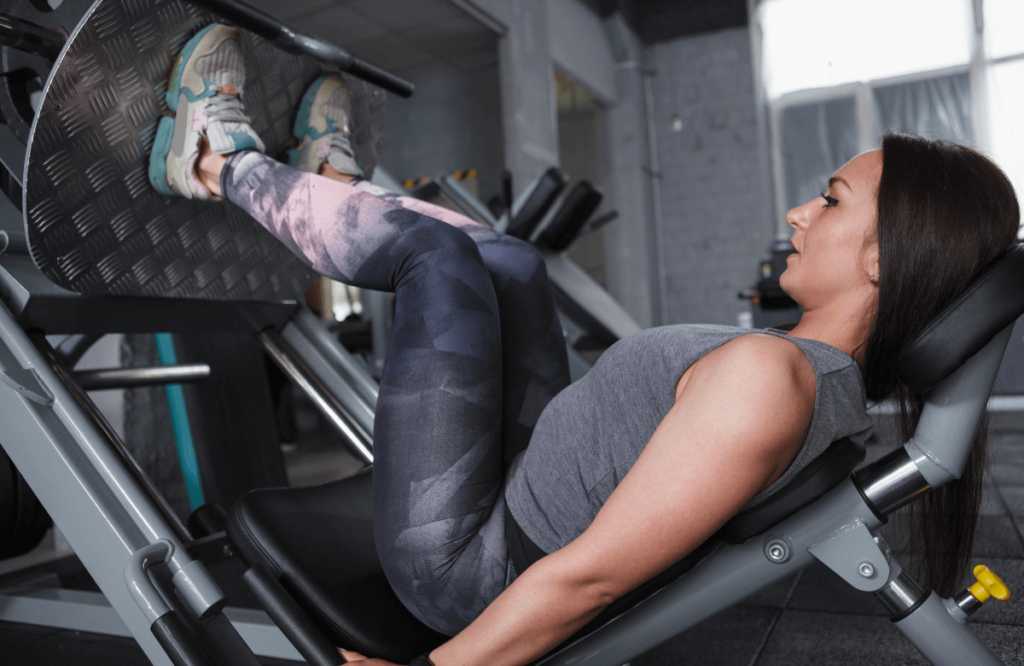
Frequently Asked Questions (FAQ)
Can You Build Glutes With Leg Press?
Yes, the leg press targets several muscles in the lower body, including the glutes, hamstrings, quads, and calves. Deeper reps, wide foot stances, and placing your feet higher on the foot platform can help you engage the glutes even more.
What Form of Leg Press Is Best for the Glutes?
The best way to target the glutes on the leg press is to use a high foot placement with a broader stance. Pointing your toes outward and performing deeper repetitions can also help you target the glutes. Avoid locking out the knees or adjust your technique if you notice discomfort.
Is It Okay to Replace Squats With Leg Press?
The answer will depend on your fitness goals. Generally speaking, the leg press is not an adequate substitute for the squat. The barbell squat is a compound movement that does more than just build strength. The exercise strengthens your core and posterior chain and can help with balance, mobility, and daily activities.



